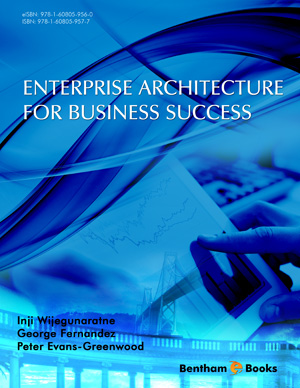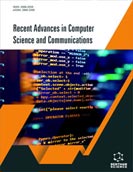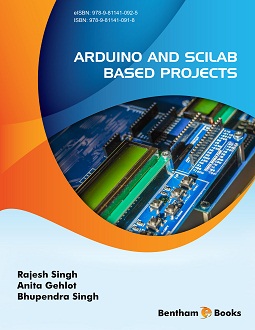Preface
Page: iii-iv (2)
Author: Inji Wijegunaratne, George Fernandez and Peter Evans-Greenwood
DOI: 10.2174/9781608059560114010002
Author Biographies
Page: v-viii (4)
Author: Inji Wijegunaratne, George Fernandez and Peter Evans-Greenwood
DOI: 10.2174/9781608059560114010003
Background
Page: 3-8 (6)
Author: Inji Wijegunaratne, George Fernandez and Peter Evans-Greenwood
DOI: 10.2174/9781608059560114010004
PDF Price: $15
Abstract
This chapter introduces the subject by surveying the scene: a brief account of the origins and growth of the discipline is presented, some definitions of the term “Enterprise Architecture” and some representative answers to the question, “why Enterprise Architecture?” are introduced, as are a set of terms related to enterprise architecture.
What is the Problem with EA?
Page: 9-13 (5)
Author: Inji Wijegunaratne, George Fernandez and Peter Evans-Greenwood
DOI: 10.2174/9781608059560114010005
PDF Price: $15
Abstract
This chapter presents our view of the problems with “Enterprise Architecture” as it is commonly understood and conducted today. We sow the seeds of our perspective of Enterprise Architecture, planting its roots in the business of the enterprise. We argue that EA conducted as an IT exercise focusing mainly on technical aspects is often the reason for the lack of success of EA engagements, and that in order to succeed, the EA team needs to deliver value to the business at the speed that the business needs.
EA Imperatives, Drivers and Objectives
Page: 14-24 (11)
Author: Inji Wijegunaratne, George Fernandez and Peter Evans-Greenwood
DOI: 10.2174/9781608059560114010006
PDF Price: $15
Abstract
EA is about enterprise evolution and, as such, it has been often compared with the evolution of a city. This is quite appropriate as-similarly to enterprises-cities are complex and dynamic organizations that need to respond to a changing environment.
In this chapter we provide an analogy for an enterprise architecture exercise by way of planning the future of a city, introducing, through this setting, some key concepts that we elaborate upon later, for instance the levels of detail relevant to each stage of the planning process. We draw upon the learnings from this example to propose a 3-stage approach to conduct an EA exercise: Align, Elaborate and Govern.
The Architecture of EA
Page: 25-43 (19)
Author: Inji Wijegunaratne, George Fernandez and Peter Evans-Greenwood
DOI: 10.2174/9781608059560114010007
PDF Price: $15
Abstract
This chapter dissects the structure of Enterprise Architecture, not be delving into detail, but by “stepping back”. We describe the various facets of the term “Enterprise Architecture”: Context, Content and Process. We then analyse options for the scope of EA, from an ideal (or idealistic) scope of EA at one end, to the typical IT-driven EA at the other. We propose a pragmatic and achievable scope and approach to EA between these two ends, based on the strategic fit of business and IT.
Each of the three stages introduced in Chapter 3- Align, Elaborate and Govern-is then discussed under this new light.
Section 3: Introduction
Page: 44-45 (2)
Author: Inji Wijegunaratne, George Fernandez and Peter Evans-Greenwood
DOI: 10.2174/9781608059560114010008
Alignment
Page: 46-100 (55)
Author: Inji Wijegunaratne, George Fernandez and Peter Evans-Greenwood
DOI: 10.2174/9781608059560114010009
PDF Price: $15
Abstract
To detail the main meaningful activities of EA, in chapters 5, 6 and 7 we go through a scenario illustrating the lifecycle of a pragmatic, business aligned EA development exercise.
Chapter 5 covers the first, crucial stage of our EA lifecycle: Align. The main activities, tools, techniques and artefacts for the alignment phase are introduced.
Elaborate
Page: 101-121 (21)
Author: Inji Wijegunaratne, George Fernandez and Peter Evans-Greenwood
DOI: 10.2174/9781608059560114010010
PDF Price: $15
Abstract
The align stage assists with the clarification of business objectives, to produce a set of high level initiatives which have in principle support by the stakeholders. This, “Elaborate” chapter now picks up the thread to provide the technical leadership for planning the transition represented by the identified initiatives. This advances the EA programme from alignment to elaboration: here is where we elaborate on the architecture to a level of detail that will support navigating the organisational journey that we have identified.
Govern
Page: 122-146 (25)
Author: Inji Wijegunaratne, George Fernandez and Peter Evans-Greenwood
DOI: 10.2174/9781608059560114010011
PDF Price: $15
Abstract
The final stage, Govern is presented here. It is time to deliver on the promises. We now introduce more of the organisational complexity into the equation, in that this architecture program is being executed in the backdrop of a functioning enterprise, which has to continue to function. The different aspects of governance - conformance with business priorities and direction, with architecture, and following up on IT performance and capability are the main themes of this chapter.
How Our Approach Adds Value
Page: 147-163 (17)
Author: Inji Wijegunaratne, George Fernandez and Peter Evans-Greenwood
DOI: 10.2174/9781608059560114010012
PDF Price: $15
Abstract
This eBook predicates the EA must add, and demonstrate that it does, add value to the enterprise. This chapter explores our concept of value, value indicators, and how to quantify and provide evidence that EA is adding and optimizing value.
Case Studies
Page: 164-200 (37)
Author: Inji Wijegunaratne, George Fernandez and Peter Evans-Greenwood
DOI: 10.2174/9781608059560114010013
PDF Price: $15
Abstract
In previous chapters we observed how enterprise architecture programs are often unsuccessful, with many not progressing past the initial stages losing support and momentum, or running to a conclusion only for their output to be reduced to shelfware.
This chapter presents case studies of three quite different projects from our experience that in their own ways avoided these relevance problems plaguing EA.
Wrap Up
Page: 201-207 (7)
Author: Inji Wijegunaratne, George Fernandez and Peter Evans-Greenwood
DOI: 10.2174/9781608059560114010014
PDF Price: $15
References
Page: 208-208 (1)
Author: Inji Wijegunaratne, George Fernandez and Peter Evans-Greenwood
DOI: 10.2174/9781608059560114010015
Index
Page: 209-215 (7)
Author: Inji Wijegunaratne, George Fernandez and Peter Evans-Greenwood
DOI: 10.2174/9781608059560114010016
Introduction
Enterprise Architecture (EA) has evolved to become a prominent presence in today’s information systems and technology landscape. The EA discipline is rich in frameworks, methodologies, and the like. However, the question of ‘value’ for business ;professionals remains largely unanswered – that is, how best can Enterprise Architecture and Enterprise Architects deliver value to the enterprise? Enterprise Architecture for Business Success answers this question. Enterprise Architecture for Business Success is primarily intended for IT professionals working in the area of Enterprise Architecture. The eBook gives practical insights into what constitutes EA and how it might be practiced in a typical resource constrained business environment. The contents of the eBook include a brief guideline about EA systems and terminology, followed by notes on how to design enterprise systems in line with business strategies. The eBook also presents case studies which help to demonstrate the distance between theory and reality when it comes to optimizing IT infrastructure for successfully achieving business goals. Lengthy theoretical discussions are avoided in favor of focusing more on the practice and tools of EA. Readers will find value in this eBook, whether they are an IT consultant or a manager, an EA team lead or member, or just someone keen to learn about real-world EA.






















